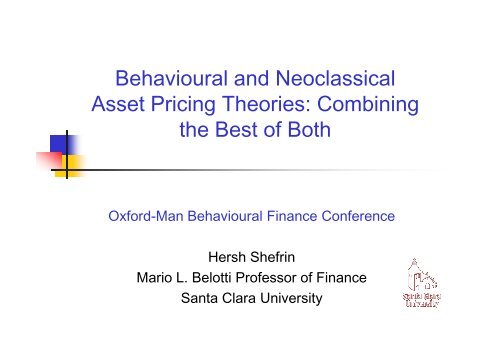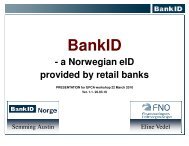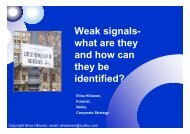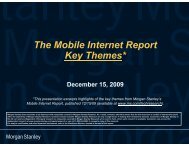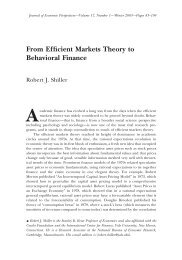Shefrin - Behavioral & Neoclassical asset pricing theories - 2008
Shefrin - Behavioral & Neoclassical asset pricing theories - 2008
Shefrin - Behavioral & Neoclassical asset pricing theories - 2008
Create successful ePaper yourself
Turn your PDF publications into a flip-book with our unique Google optimized e-Paper software.
Behavioural and <strong>Neoclassical</strong><br />
Asset Pricing Theories: Combining<br />
the Best of Both<br />
Oxford-Man Behavioural Finance Conference<br />
Hersh <strong>Shefrin</strong><br />
Mario L. Belotti Professor of Finance<br />
Santa Clara University
Outline<br />
<br />
<br />
<br />
Looking back.<br />
<strong>Neoclassical</strong> and behavioural <strong>asset</strong> <strong>pricing</strong><br />
<strong>theories</strong><br />
<br />
strengths and weaknesses.<br />
Behaviourally-based SDF approach.<br />
<br />
<br />
<br />
Formal definition of sentiment.<br />
How sentiment is manifest within <strong>asset</strong> prices.<br />
Unified treatment of behavioural beliefs and<br />
behavioural preferences.<br />
Copyright Hersh <strong>Shefrin</strong> <strong>2008</strong><br />
1
<strong>Neoclassical</strong><br />
Asset Pricing Theory<br />
<br />
Modern <strong>asset</strong> <strong>pricing</strong> theory is based on the<br />
SDF.<br />
<strong>Neoclassical</strong> treatment in Cochrane (2005).<br />
<br />
<br />
Strength of approach is power of analytical<br />
techniques in unified, coherent framework.<br />
Weakness is unrealistic rationality<br />
assumptions and the absence of<br />
psychologically realistic assumptions.<br />
Copyright Hersh <strong>Shefrin</strong> <strong>2008</strong><br />
2
Behavioural<br />
Asset Pricing Theories<br />
<br />
<br />
Behavioural <strong>asset</strong> <strong>pricing</strong> models involve<br />
assumptions that reflect human psychology.<br />
Strength of behavioural models is focus on<br />
rich features such as:<br />
<br />
<br />
<br />
Heuristics and biases such as overconfidence,<br />
gambler’s fallacy and hot hand fallacy<br />
Fundamental attribution error<br />
Gains/losses, conditional risk tolerance, probability<br />
weighting<br />
Copyright Hersh <strong>Shefrin</strong> <strong>2008</strong><br />
3
Weaknesses in Behavioural<br />
Asset Pricing Literature<br />
The behavioural <strong>asset</strong> <strong>pricing</strong> journal<br />
literature lacks a well-defined formal<br />
definition of sentiment.<br />
Models largely restricted to one risk-free<br />
<strong>asset</strong> and one risky <strong>asset</strong>.<br />
Psychological assumptions vary<br />
considerably from model to model.<br />
Copyright Hersh <strong>Shefrin</strong> <strong>2008</strong><br />
4
Best of Both Worlds<br />
<br />
I argue that going forward <strong>asset</strong> <strong>pricing</strong> theory<br />
will bring together psychologically-based<br />
assumptions from behavioural finance and the<br />
rigorous, integrated SDF-based methodology<br />
from neoclassical finance.<br />
<br />
<br />
Behavioural features will improve upon the<br />
neoclassical assumption of perfect rationality.<br />
<strong>Neoclassical</strong> methodology will improve upon the ad<br />
hoc, fragmented approach that is characteristic of<br />
the current behavioural <strong>asset</strong> <strong>pricing</strong> journal<br />
literature.<br />
Copyright Hersh <strong>Shefrin</strong> <strong>2008</strong><br />
5
BAAP 2e<br />
The rest of my talk will describe<br />
the elements of a behavioural<br />
SDF-based approach.<br />
This is the approach described in<br />
BAAP.<br />
2 nd edition just out.<br />
Copyright Hersh <strong>Shefrin</strong> <strong>2008</strong><br />
6
Quick Survey<br />
What is your expectation for the return<br />
to the S&P 500 over the next 12<br />
months?<br />
Quick tally.<br />
Copyright Hersh <strong>Shefrin</strong> <strong>2008</strong><br />
7
Heterogeneity is Behavioural<br />
Challenge is Market Aggregation<br />
Distribution of Average of Survey Expected Returns 1998 - 2001<br />
35%<br />
30%<br />
1998 2001<br />
Relative Frequency<br />
25%<br />
20%<br />
15%<br />
10%<br />
5%<br />
0%<br />
30%<br />
Expected Return<br />
Copyright Hersh <strong>Shefrin</strong> <strong>2008</strong><br />
8
Behavioural Aggregation<br />
Begin with neoclassical EU model with<br />
CRRA preferences and complete<br />
markets.<br />
In respect to judgments, markets<br />
aggregate pdfs, not moments.<br />
Generalized Hölder average theorem.<br />
In respect to preferences, markets<br />
aggregate coefficients of risk tolerance<br />
(inverse of CRRA).<br />
Copyright Hersh <strong>Shefrin</strong> <strong>2008</strong><br />
9
Representative Investor Models<br />
Many <strong>asset</strong> <strong>pricing</strong> theorists, from both<br />
neoclassical and behavioural camps,<br />
assume a representative investor in<br />
their models.<br />
Aggregation theorem suggests that the<br />
representative investor assumption is<br />
typically invalid.<br />
Copyright Hersh <strong>Shefrin</strong> <strong>2008</strong><br />
10
Representativeness Bias<br />
In Academic Research<br />
It is typically invalid to assume the<br />
existence of a representative investor<br />
with expected utility preferences and<br />
correct beliefs.<br />
It is typically invalid to assume the<br />
existence of a representative investor<br />
with prospect theory preferences whose<br />
beliefs exhibit common behavioural<br />
biases.<br />
Copyright Hersh <strong>Shefrin</strong> <strong>2008</strong><br />
11
Simple Example of T14.1<br />
Errors in First Moments Only<br />
Complete markets, 2 investors<br />
equal wealth.<br />
CRRA = 1, log-utility.<br />
One investor is excessively bullish<br />
about mean returns, the other is<br />
excessively bearish.<br />
Correct beliefs about volatility.<br />
How does the market aggregate the<br />
different investor judgments?<br />
Copyright Hersh <strong>Shefrin</strong> <strong>2008</strong><br />
12
Market (Red) Aggregates pdfs<br />
Blue Aggregates Moments<br />
Underlying Probability Density Functions<br />
0.045<br />
0.040<br />
0.035<br />
0.030<br />
0.025<br />
0.020<br />
0.015<br />
Bearish Density<br />
Objective Density<br />
Bullish Density<br />
Equilibrium Density<br />
0.010<br />
0.005<br />
0.000<br />
96%<br />
97%<br />
98%<br />
100%<br />
101%<br />
102%<br />
103%<br />
105%<br />
106%<br />
Consumption Growth g (Gross Rate)<br />
Copyright Hersh <strong>Shefrin</strong> <strong>2008</strong><br />
13
Defining Sentiment Intuitively<br />
In these examples, sentiment is a<br />
function that indicates by what % the<br />
market’s (equilibrium) probability density<br />
exceeds the objective probability density.<br />
Market efficiency Sentiment = 0<br />
Copyright Hersh <strong>Shefrin</strong> <strong>2008</strong><br />
14
Sentiment<br />
Probability<br />
0.045<br />
6<br />
0.040<br />
0.035<br />
0.030<br />
5<br />
0.025<br />
Bearish Density<br />
Bullish Density<br />
0.020<br />
Objective Density ¬<br />
0.015<br />
Equilibrium Density PM<br />
4<br />
0.010<br />
0.005<br />
3<br />
0.000<br />
96%<br />
97%<br />
98%<br />
100%<br />
101%<br />
102%<br />
103%<br />
105%<br />
106%<br />
Consumption Growth g (Gross Rate)<br />
2<br />
1<br />
0<br />
96%<br />
97%<br />
98%<br />
100%<br />
101%<br />
102%<br />
103%<br />
105%<br />
106%<br />
-1<br />
Consumption Growth Rate g (Gross)<br />
Copyright Hersh <strong>Shefrin</strong> <strong>2008</strong><br />
15
Formally Defining Sentiment Λ<br />
General Model<br />
Measured by the random variable<br />
Λ = ln(P R (x t ) / Π(x t )) + ln(δ R / δ R , Π )<br />
<br />
<br />
δ R , Π is the δ R that results when all traders hold<br />
objective beliefs<br />
Sentiment is not a scalar, but a stochastic<br />
process < Λ, Π>, involving a log-change of<br />
measure.<br />
Copyright Hersh <strong>Shefrin</strong> <strong>2008</strong><br />
16
Market Efficiency<br />
Sentiment Λ = 0<br />
The market is efficient when the<br />
representative trader, aggregating the<br />
beliefs of all traders, holds objective<br />
beliefs.<br />
<br />
and<br />
i.e., efficiency iff P R = Π<br />
When all investors hold objective beliefs<br />
Φ = (P R /Π) (δ R / δ R , Π ) = 1<br />
Λ = ln(Φ) = 0<br />
Copyright Hersh <strong>Shefrin</strong> <strong>2008</strong><br />
17
When is Sentiment = 0?<br />
Consider the illustrative example.<br />
There are effectively two conditions<br />
required for market efficiency.<br />
Errors are unsystematic, meaning average<br />
error across the investor population is zero.<br />
Error-wealth covariance = 0, meaning<br />
errors are not concentrated in the investor<br />
population.<br />
Copyright Hersh <strong>Shefrin</strong> <strong>2008</strong><br />
18
What is the Shape of<br />
the Sentiment Function?<br />
Begin with case when investors have<br />
log-normal beliefs and log-utility.<br />
Mistakes about 1 st moments but not<br />
about 2 nd moments.<br />
Here are some examples of shapes and<br />
what they reflect.<br />
Copyright Hersh <strong>Shefrin</strong> <strong>2008</strong><br />
19
106.19%<br />
105.82%<br />
105.46%<br />
Shape of Sentiment Function<br />
Optimism - Bullishness<br />
105.10%<br />
Sentiment Function<br />
0.8<br />
0.6<br />
0.4<br />
0.2<br />
0<br />
20<br />
104.74%<br />
95.82%<br />
96.15%<br />
96.48%<br />
96.81%<br />
97.14%<br />
97.48%<br />
97.81%<br />
98.15%<br />
98.48%<br />
98.82%<br />
99.16%<br />
99.50%<br />
99.84%<br />
100.18%<br />
100.53%<br />
100.87%<br />
101.22%<br />
101.56%<br />
101.91%<br />
102.26%<br />
102.61%<br />
102.96%<br />
103.32%<br />
103.67%<br />
104.03%<br />
104.38%<br />
-0.2<br />
-0.4<br />
-0.6<br />
-0.8<br />
Copyright Hersh <strong>Shefrin</strong> <strong>2008</strong><br />
Consumption Growth Rate g (Gross)
Change of Measure is Log-linear<br />
Typical for a variance preserving, right<br />
shift in mean for normally distributed<br />
variable.<br />
This function applies to sentiment of<br />
individual investor as well as to<br />
sentiment of the market.<br />
Copyright Hersh <strong>Shefrin</strong> <strong>2008</strong><br />
21
106.19%<br />
105.82%<br />
105.46%<br />
105.10%<br />
104.74%<br />
Bearishness - Pessimism<br />
104.38%<br />
Sentiment Function<br />
0.8<br />
0.6<br />
22<br />
0.4<br />
0.2<br />
0<br />
95.82%<br />
96.15%<br />
96.48%<br />
96.81%<br />
97.14%<br />
97.48%<br />
97.81%<br />
98.15%<br />
98.48%<br />
98.82%<br />
99.16%<br />
99.50%<br />
99.84%<br />
100.18%<br />
100.53%<br />
100.87%<br />
101.22%<br />
101.56%<br />
101.91%<br />
102.26%<br />
102.61%<br />
102.96%<br />
103.32%<br />
104.03%<br />
103.67%<br />
-0.2<br />
-0.4<br />
-0.6<br />
-0.8<br />
Copyright Hersh <strong>Shefrin</strong> <strong>2008</strong><br />
Consumption Growth Rate g (Gross)
106.19%<br />
105.82%<br />
105.46%<br />
105.10%<br />
104.74%<br />
Mix of Bulls and Bears<br />
104.38%<br />
Sentiment Function<br />
23<br />
0.25<br />
0.2<br />
0.15<br />
0.1<br />
0.05<br />
0<br />
95.82%<br />
96.15%<br />
96.48%<br />
96.81%<br />
97.14%<br />
97.48%<br />
97.81%<br />
98.15%<br />
98.48%<br />
98.82%<br />
99.16%<br />
99.50%<br />
99.84%<br />
100.18%<br />
100.53%<br />
100.87%<br />
101.22%<br />
101.56%<br />
101.91%<br />
102.26%<br />
102.61%<br />
104.03%<br />
102.96%<br />
103.32%<br />
103.67%<br />
-0.05<br />
Copyright Hersh <strong>Shefrin</strong> <strong>2008</strong><br />
Consumption Growth Rate g (Gross)
Mistakes About 2 nd Moments<br />
Suppose that investor make mistakes<br />
about 2 nd moments.<br />
The most likely mistake stems from<br />
investor overconfidence.<br />
This means that investors<br />
underestimate the 2 nd moment.<br />
What shape will the sentiment function<br />
assume?<br />
Copyright Hersh <strong>Shefrin</strong> <strong>2008</strong><br />
24
106.19%<br />
Overconfidence With Homogeneous<br />
Errors About 1 st Moments<br />
Sentiment Function<br />
0.5<br />
0<br />
95.82%<br />
96.15%<br />
96.48%<br />
96.81%<br />
97.14%<br />
97.48%<br />
97.81%<br />
98.15%<br />
98.48%<br />
98.82%<br />
99.16%<br />
99.50%<br />
99.84%<br />
100.18%<br />
100.53%<br />
100.87%<br />
101.22%<br />
101.56%<br />
101.91%<br />
102.26%<br />
102.61%<br />
102.96%<br />
103.32%<br />
103.67%<br />
104.03%<br />
104.38%<br />
104.74%<br />
105.10%<br />
105.46%<br />
105.82%<br />
-0.5<br />
-1<br />
-1.5<br />
-2<br />
25<br />
-2.5<br />
Copyright Hersh <strong>Shefrin</strong> <strong>2008</strong><br />
Consumption Growth Rate g (Gross)
106.19%<br />
Mix of Underconfident Pessimist<br />
and Overconfident Optimist<br />
Sentiment Function<br />
0.6<br />
0.5<br />
0.4<br />
0.3<br />
26<br />
0.2<br />
0.1<br />
0<br />
105.82%<br />
95.82%<br />
96.15%<br />
96.48%<br />
96.81%<br />
97.14%<br />
97.48%<br />
97.81%<br />
98.15%<br />
98.48%<br />
98.82%<br />
99.16%<br />
99.50%<br />
99.84%<br />
100.18%<br />
100.53%<br />
100.87%<br />
101.22%<br />
101.56%<br />
101.91%<br />
102.26%<br />
102.61%<br />
102.96%<br />
103.32%<br />
103.67%<br />
104.03%<br />
104.38%<br />
104.74%<br />
105.10%<br />
105.46%<br />
-0.1<br />
-0.2<br />
Copyright Hersh <strong>Shefrin</strong> <strong>2008</strong><br />
Consumption Growth Rate g (Gross)
Empirical Evidence<br />
on Investor Mix<br />
Several sources for return expectations<br />
UBS/Gallup for individual investors<br />
Livingston data for professional forecasters<br />
Wall $treet Week for analysts, strategists,<br />
and money managers<br />
BusinessWeek for market strategists.<br />
What do the distributions look like?<br />
Copyright Hersh <strong>Shefrin</strong> <strong>2008</strong><br />
27
Histogram Return Expectations December 1998 for 1999<br />
40%<br />
35%<br />
UBS<br />
30%<br />
Livingston<br />
Relative Frequency<br />
25%<br />
20%<br />
15%<br />
W$W<br />
BusinessWeek<br />
10%<br />
5%<br />
0%<br />
30%<br />
Percent Change<br />
Copyright Hersh <strong>Shefrin</strong> <strong>2008</strong><br />
28
Distribution of Average of Survey Expected Returns 1998 - 2001<br />
35%<br />
30%<br />
1998 2001<br />
25%<br />
Relative Frequency<br />
20%<br />
15%<br />
10%<br />
5%<br />
0%<br />
30%<br />
Expected Return<br />
Copyright Hersh <strong>Shefrin</strong> <strong>2008</strong><br />
29
Pricing Kernel (SDF)<br />
Stochastic discount factor is a state<br />
price per unit probability.<br />
SDF version 1 M = ν/Π<br />
SDF version 2 <br />
M = ν/P R<br />
Both different routes to studying the effect<br />
of sentiment Λ on prices.<br />
Price of any one-period security Z is<br />
q Z = νZ = E π {MZ}<br />
E t [R i,t+1 M t+1 ] = 1<br />
30<br />
Copyright Hersh <strong>Shefrin</strong> <strong>2008</strong>
T16.1. Decomposition of SDF<br />
m ≡ ln(M)<br />
m = Λ - γ R ln(g) + ln(δ R,Π )<br />
Process <br />
Note: In CAPM with market<br />
efficiency, M is linear in g with a<br />
negative coefficient.<br />
Copyright Hersh <strong>Shefrin</strong> <strong>2008</strong><br />
31
106.19%<br />
105.82%<br />
105.46%<br />
105.10%<br />
104.74%<br />
104.38%<br />
60.00%<br />
50.00%<br />
40.00%<br />
30.00%<br />
ln(SDF)<br />
20.00%<br />
10.00%<br />
ln SDF & Sentiment<br />
104.03%<br />
Sentiment<br />
Function<br />
32<br />
0.00%<br />
95.82%<br />
96.15%<br />
96.48%<br />
96.81%<br />
97.14%<br />
97.48%<br />
97.81%<br />
98.15%<br />
98.48%<br />
98.82%<br />
99.16%<br />
99.50%<br />
99.84%<br />
100.18%<br />
100.53%<br />
100.87%<br />
101.22%<br />
101.56%<br />
101.91%<br />
102.26%<br />
102.61%<br />
103.67%<br />
102.96%<br />
103.32%<br />
-10.00%<br />
ln(g)<br />
-20.00%<br />
-30.00%<br />
Copyright Hersh <strong>Shefrin</strong> <strong>2008</strong><br />
Gross Consumption Growth Rate g
How Different is a Behavioural SDF<br />
From a Traditional <strong>Neoclassical</strong> SDF?<br />
<strong>Behavioral</strong> SDF vs Traditional SDF<br />
1.2<br />
1.15<br />
<strong>Behavioral</strong> SDF<br />
1.1<br />
1.05<br />
1<br />
0.95<br />
0.9<br />
Traditional <strong>Neoclassical</strong> SDF<br />
0.85<br />
0.8<br />
96%<br />
97%<br />
97%<br />
98%<br />
99%<br />
100%<br />
101%<br />
102%<br />
103%<br />
103%<br />
104%<br />
105%<br />
106%<br />
Aggregate Consumption Growth Rate g (Gross)<br />
Copyright Hersh <strong>Shefrin</strong> <strong>2008</strong><br />
33
Fundamental Theorem for<br />
U-shaped Case<br />
ln SDF & Sentiment<br />
25%<br />
20%<br />
15%<br />
ln(SDF)<br />
Sentiment<br />
10%<br />
5%<br />
0%<br />
95.8%<br />
96.6%<br />
97.5%<br />
98.3%<br />
99.2%<br />
100.0%<br />
100.9%<br />
101.7%<br />
102.6%<br />
103.5%<br />
104.4%<br />
105.3%<br />
106.2%<br />
-5%<br />
ln(g)<br />
-10%<br />
Gross Consumption Growth Rate g<br />
Copyright Hersh <strong>Shefrin</strong> <strong>2008</strong><br />
34
The AFLAC Duck<br />
Behavioural Arrow-Debreu ’87<br />
WFA ’89<br />
<strong>Shefrin</strong>-Statman ’94<br />
Chicago Board of Trade ’97<br />
Univ Michigan ’99<br />
<strong>Neoclassical</strong> & behavioural status<br />
quo bias?<br />
It’s sentiment<br />
~ change of measure!<br />
Copyright Hersh <strong>Shefrin</strong> <strong>2008</strong><br />
35
Market Prices Reflect<br />
Both Fundamentals and Sentiment<br />
Fundamental behavioural theorem<br />
about the SDF, the market’s DNA.<br />
The log-SDF can be decomposed into<br />
the sum of a neoclassical fundamental<br />
component and sentiment.<br />
SDF provides an integrated approach to<br />
<strong>asset</strong> <strong>pricing</strong>.<br />
Copyright Hersh <strong>Shefrin</strong> <strong>2008</strong><br />
36
Empirical SDF<br />
Aït-Sahalia and Lo (2000) study<br />
economic VaR for risk management,<br />
and estimate the SDF.<br />
Rosenberg and Engle (2002) also<br />
estimate the SDF.<br />
Both use index option data in<br />
conjunction with empirical return<br />
distribution information.<br />
What does the empirical SDF look like?<br />
Copyright Hersh <strong>Shefrin</strong> <strong>2008</strong><br />
37
Aït-Sahalia – Lo’s SDF Estimate<br />
What underlies the lumps and bumps?<br />
Copyright Hersh <strong>Shefrin</strong> <strong>2008</strong><br />
38
Rosenberg-Engle’s SDF Estimate<br />
What accounts for the difference in the two curves?<br />
How to<br />
measure<br />
sentiment?<br />
Sample Computation at Left<br />
sentiment = ln(SDF)-ln(fundamental component)<br />
ln(SDF) = ln(5.0) = 1.61<br />
ln(fundamental component) = ln(2.25) = 0.81<br />
sentiment = 79.9%<br />
Copyright Hersh <strong>Shefrin</strong> <strong>2008</strong><br />
39
Dittmar (2002)<br />
Human Capital<br />
Copyright Hersh <strong>Shefrin</strong> <strong>2008</strong><br />
40
Pricing Kernel (SDF)<br />
Stochastic discount factor is a state<br />
price per unit probability.<br />
SDF version 1 M = ν/Π<br />
SDF version 2 M = ν/P R<br />
Both different routes to studying the<br />
effect of sentiment Λ on prices.<br />
But route 2, using P R , leads to a<br />
neoclassical, downward sloping SDF<br />
without the lumps and bumps.<br />
SDF version 2 M = ν/P R<br />
41<br />
Copyright Hersh <strong>Shefrin</strong> <strong>2008</strong>
Barone Adesi-<br />
Engle-Mancini (<strong>2008</strong>)<br />
<br />
<br />
<br />
<br />
<br />
Empirical SDF based on index options data for<br />
1/2002 – 12/2004.<br />
Asymmetric volatility and negative skewness<br />
of filtered historical innovations.<br />
Equality broken between physical and risk<br />
neutral volatilities.<br />
BEM obtain a neoclassical SDF!<br />
When BEM use the traditional Gaussian<br />
approach for the period they study, the<br />
estimated SDF features the behavioural<br />
oscillating shape.<br />
Copyright Hersh <strong>Shefrin</strong> <strong>2008</strong><br />
42
Mean-Variance Efficiency<br />
Is there a different path to establishing<br />
whether the SDF is neoclassical or<br />
behavioural?<br />
What does sentiment imply about the<br />
nature of the returns to a mean-variance<br />
efficient portfolio?<br />
What is the priced risk which investors<br />
face?<br />
Copyright Hersh <strong>Shefrin</strong> <strong>2008</strong><br />
43
Relationship Between SDF and<br />
Mean-Variance Returns<br />
Theorem 17.1<br />
r MV = a – bM<br />
where<br />
a = ξ, whose variation generates the MVfrontier<br />
<br />
The higher is ξ, the stronger the linear term<br />
relative to the quadratic term in the quadratic<br />
utility function<br />
b = (ξ/i 1 – 1) / E Π (M 2 )<br />
Copyright Hersh <strong>Shefrin</strong> <strong>2008</strong><br />
44
How Different are Returns to a Behavioural<br />
MV-Portfolio From <strong>Neoclassical</strong> Counterpart?<br />
110%<br />
Gross Return to Mean-variance Portfolio:<br />
<strong>Behavioral</strong> Mean-Variance Return vs Efficient Mean-Variance Return<br />
105%<br />
100%<br />
Mean-variance Return<br />
95%<br />
90%<br />
85%<br />
<strong>Neoclassical</strong> Efficient MV Portfolio Return<br />
<strong>Behavioral</strong> MV Portfolio Return<br />
80%<br />
75%<br />
96%<br />
97%<br />
99%<br />
101%<br />
103%<br />
104%<br />
106%<br />
Consumption Growth Rate g (Gross)<br />
Copyright Hersh <strong>Shefrin</strong> <strong>2008</strong><br />
45
MV Function ∼ Quadratic<br />
2-factor Model, Mkt and Mkt 2<br />
Gross Return to Mean-variance Portfolio:<br />
<strong>Behavioral</strong> Mean-Variance Return vs Efficient Mean-Variance Return<br />
1.03<br />
1.02<br />
Efficient MV Portfolio Return<br />
1.01<br />
Mean-variance Return<br />
1<br />
0.99<br />
0.98<br />
0.97<br />
<strong>Behavioral</strong> MV Portfolio Return<br />
Return to a Combination of the Market Portfolio and<br />
Risk-free Security<br />
0.96<br />
0.95<br />
95.82%<br />
96.64%<br />
97.48%<br />
98.31%<br />
99.16%<br />
100.01%<br />
100.87%<br />
101.74%<br />
102.61%<br />
103.49%<br />
104.38%<br />
105.28%<br />
106.19%<br />
Consumption Growth Rate g (Gross)<br />
Copyright Hersh <strong>Shefrin</strong> <strong>2008</strong><br />
46
When a Coskewness Model<br />
Works Exactly<br />
The MV return function is quadratic in g,<br />
risk is priced according to a 2-factor<br />
model.<br />
The factors are g (the market portfolio<br />
return) and g 2 , whose coefficient<br />
corresponds to co-skewness.<br />
Copyright Hersh <strong>Shefrin</strong> <strong>2008</strong><br />
47
Oscillating SDF<br />
<br />
<br />
The general<br />
oscillating shape is<br />
similar to the U-<br />
shaped at the left,<br />
and deviates at the<br />
right.<br />
The market and<br />
coskewness are<br />
<strong>pricing</strong> factors, but<br />
there are other<br />
factors.<br />
1.2<br />
1.15<br />
1.1<br />
1.05<br />
1<br />
0.95<br />
0.9<br />
0.85<br />
0.8<br />
96%<br />
97%<br />
97%<br />
<strong>Behavioral</strong> SDF vs Traditional SDF<br />
<strong>Behavioral</strong> SDF<br />
Traditional <strong>Neoclassical</strong> SDF<br />
98%<br />
99%<br />
100%<br />
101%<br />
102%<br />
103%<br />
103%<br />
104%<br />
Aggregate Consumption Growth Rate g (Gross)<br />
105%<br />
106%<br />
Copyright Hersh <strong>Shefrin</strong> <strong>2008</strong><br />
48
What We Know About<br />
the Pricing and Coskewness<br />
Barone-Adesi and Talwar (1983).<br />
Harvey-Siddique (2000).<br />
The correlation between coskewness and<br />
mean returns of portfolios sorted by size,<br />
book-to-market equity, and momentum is -<br />
0.71.<br />
This means that much of the explanatory<br />
power of size, B/M, and momentum<br />
plausibly derives from coskewness.<br />
Copyright Hersh <strong>Shefrin</strong> <strong>2008</strong><br />
49
Additional Explanatory Power<br />
<br />
<br />
<br />
<br />
CAPM only explains 3.5% of cross-sectional<br />
returns.<br />
But CAPM + coskewness explains 68.1% of<br />
cross-sectional returns!<br />
Market, size, and B/M explain 71.8%.<br />
For momentum, recent winners feature lower<br />
coskewness than that of recent losers.<br />
Other factors? Empirical evidence in Barone<br />
Adesi, Gagliardini, Urga<br />
Copyright Hersh <strong>Shefrin</strong> <strong>2008</strong><br />
50
Prospect Theory<br />
Prospect theory has provided an<br />
important focal point for identifying<br />
where expected utility theory fails as a<br />
descriptive framework.<br />
Unfortunately, prospect theory itself has<br />
very severe weaknesses.<br />
<strong>Shefrin</strong>-Statman (1985)<br />
Hens-Vlcek (2006)<br />
Barberis-Xiong (forthcoming)<br />
De Georgi, Hens, Rieger (<strong>2008</strong>)<br />
Copyright Hersh <strong>Shefrin</strong> <strong>2008</strong><br />
51
My prediction is that <strong>asset</strong> <strong>pricing</strong> theory<br />
will develop around some alternative<br />
psychologically-based risk theory to<br />
capture behavioural preferences.<br />
<strong>Shefrin</strong>-Statman (2000) develop<br />
behavioural portfolio theory around<br />
SP/A theory (Lopes 1987).<br />
Copyright Hersh <strong>Shefrin</strong> <strong>2008</strong><br />
52
SP/A Theory & Prospect Theory<br />
<br />
<br />
<br />
<br />
SP/A theory is more tractable to use in<br />
respect to <strong>asset</strong> <strong>pricing</strong> theory.<br />
SP/A theory provides a more parsimonious<br />
framework for understanding the psychology<br />
of risk.<br />
SP/A theory consistent with neuro-anatomy.<br />
SP/A theory explains behaviour that prospect<br />
theory cannot explain.<br />
Copyright Hersh <strong>Shefrin</strong> <strong>2008</strong><br />
53
SP/A Focuses on Hope and Fear<br />
Affect-based Representation<br />
Sentiment Function<br />
0.25<br />
0.2<br />
0.15<br />
Fear<br />
Hope<br />
(anterior insula)<br />
(nucleus accumbens)<br />
0.1<br />
0.05<br />
0<br />
106.19%<br />
95.82%<br />
96.15%<br />
96.48%<br />
96.81%<br />
97.14%<br />
97.48%<br />
97.81%<br />
98.15%<br />
98.48%<br />
98.82%<br />
99.16%<br />
99.50%<br />
99.84%<br />
100.18%<br />
100.53%<br />
100.87%<br />
101.22%<br />
101.56%<br />
101.91%<br />
102.26%<br />
102.61%<br />
102.96%<br />
103.32%<br />
103.67%<br />
104.03%<br />
104.38%<br />
104.74%<br />
105.10%<br />
105.46%<br />
105.82%<br />
-0.05<br />
Consumption Growth Rate g (Gross)<br />
54<br />
Copyright Hersh <strong>Shefrin</strong> <strong>2008</strong>
Inverse S in SP/A<br />
Rank Dependent Utility<br />
Functional Decomposition of Decumulative Weighting Function in SP/A Theory<br />
1.2<br />
1.0<br />
h2(D)<br />
0.8<br />
h(D)<br />
0.6<br />
0.4<br />
h1(D)<br />
0.2<br />
0.0<br />
0 0.1 0.2 0.3 0.4 0.5 0.6 0.7 0.8 0.9 1<br />
D<br />
Copyright Hersh <strong>Shefrin</strong> <strong>2008</strong><br />
55
SP/A “Sentiment” with<br />
Aspiration Reference Point<br />
SP/A Sentiment Function<br />
1.5%<br />
Consumption = Aspiration<br />
Level<br />
1.0%<br />
0.5%<br />
0.0%<br />
1 2 3 4 5 6 7 8<br />
-0.5%<br />
-1.0%<br />
-1.5%<br />
<br />
<br />
-2.0%<br />
State<br />
Oscillating shape and skewness.<br />
Behavioural portfolio theory, <strong>Shefrin</strong>-Statman (2000).<br />
Contribution of skewness to coskewness.<br />
Copyright Hersh <strong>Shefrin</strong> <strong>2008</strong><br />
56
Progress Since BAAP 1e<br />
<strong>Neoclassical</strong> <strong>asset</strong> <strong>pricing</strong> theorists are<br />
beginning to build behavioural SDFbased<br />
models.<br />
Jouini-Napp (2007)<br />
Dumas-Kurshev-Uppal (forthcoming)<br />
Bakshi-Wu (2006)<br />
Behavioural <strong>asset</strong> <strong>pricing</strong> theorists<br />
moving to recognition of SDF-based<br />
behavioural approach.<br />
Baker-Wurgler (2007)<br />
Copyright Hersh <strong>Shefrin</strong> <strong>2008</strong><br />
57
Summary<br />
<br />
<br />
<br />
<br />
Comprehensive SDF-based behavioural <strong>asset</strong><br />
<strong>pricing</strong> model brings together the best of what<br />
neoclassical and behavioural <strong>asset</strong> <strong>pricing</strong><br />
has to offer.<br />
Behavioural beliefs, behavioural preferences,<br />
neoclassical beliefs, neoclassical preferences.<br />
Markets aggregate pdfs, not moments.<br />
Behavioural SDF-based theory predicts how<br />
shape of SDF reflects behavioural traits of<br />
investors.<br />
Copyright Hersh <strong>Shefrin</strong> <strong>2008</strong><br />
58


